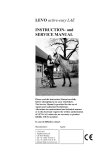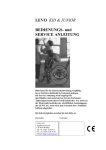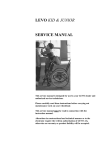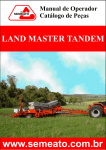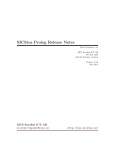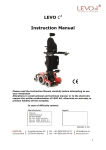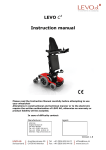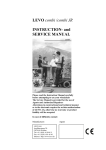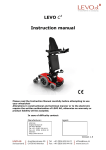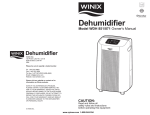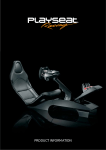Download LEVO KID & JUNIOR INSTRUCTION
Transcript
LEVO KID & JUNIOR INSTRUCTIONand SERVICE MANUAL Please read the Instruction Manual carefully before attempting to use your wheelchair. The Service Manual is provided for the use of Agents and Authorized Technicians. Alterations in constructional and technical manner or to the electronic require the written authorisation of LEVO AG, otherwise no warranty or product liability will be accepted. In case of difficulty contact: Manufacturer: LEVO AG Anglikerstrasse 20 CH-5610 Wohlen Tel:+41 (0)56 618 44 11 Fax:+41 (0)56 618 44 10 Internet: http://www.levo.ch Agent: 2 Dear Customer, We would like to thank you for putting your trust in LEVO stand-up wheelchairs. The LEVO stand-up wheelchair is a unique aid for use by those facing difficulties walking and standing up. As well as performing all the functions of an active wheelchair, the LEVO enables you to stand up on your own. Please read these operating instructions carefully before using your LEVO. They contain important information necessary for successful operation of the wheelchair. Whether you use your LEVO as a stand-up aid at work in everyday life, or to help with standing exercises, it guarantees you optimum independence, mobility and health. As a LEVO customer, you have a valuable contribution to make to the on-going further development of our products. We put great store by your suggestions, which ensure that LEVO still offers the most comprehensive service available and provides for the widest possible range of needs. Yours faithfully, LEVO AG 3 Contents Kid’s page ....................................................................................................................................6 Declaration of Conformity ...........................................................................................................8 Declaration of Conformity ...........................................................................................................9 USERMANUAL ...............................................................................................................................12 1. Introduction................................................................................................................................13 2. Guarantee ...................................................................................................................................13 3. Delivery......................................................................................................................................14 4. Accessories ................................................................................................................................14 5. Warnings ....................................................................................................................................14 6. Basic adjustments.......................................................................................................................16 6.1. Rear wheels..........................................................................................................................16 6.2. Rear wheel position .............................................................................................................16 6.3. Backrest inclination .............................................................................................................16 6.4. Armrests...............................................................................................................................17 6.5. Adjusting the seat height .....................................................................................................17 6.6. Skirt guard............................................................................................................................17 6.8. The calf/heel strap................................................................................................................18 6.9. Seat cushion (optional) ........................................................................................................18 6.10. Backrest extension (optional) .............................................................................................19 6.11. Seating systems....................................................................................................................19 6.12. Stroller handle (optional).....................................................................................................19 6.13. Stand-up operation for accompanying person (optional) ....................................................19 6.14. Other options.......................................................................................................................20 7. The brakes (wheel locks) ...........................................................................................................20 7.1. Adjusting the brakes ............................................................................................................22 8. Standing .....................................................................................................................................23 8.1. General tips ..........................................................................................................................23 8.2. Knee support ........................................................................................................................23 8.2. Knee support ........................................................................................................................23 8.3. Chest strap............................................................................................................................23 8.4. Standing up ..........................................................................................................................24 8.5. Sitting down.........................................................................................................................24 8.6. Emergency cut-out switch ...................................................................................................26 9. Batteries .....................................................................................................................................26 9.1. Recharging the batteries ......................................................................................................27 10. Handling a wheelchair ...............................................................................................................27 10.1. Getting into the wheelchair..................................................................................................27 10.2. Getting out of the wheelchair ..............................................................................................27 10.3. Sideways transfer.................................................................................................................27 10.4. Driving the wheelchair ........................................................................................................28 10.5. Danger of tipping over.........................................................................................................28 10.6. Driving on a gradient .........................................................................................................29 10.7. Negotiating obstacles...........................................................................................................29 10.8. Picking up objects from the wheelchair .................................................................................30 4 11. Storage .......................................................................................................................................32 11.1. Folding down the backrest...................................................................................................32 11.2. Removing battery and electronic unit..................................................................................32 11.3. Removing the rear wheels...................................................................................................32 11.4. Removing the front castors ..................................................................................................33 12. Lifting the wheelchair ................................................................................................................33 13. Transport in a motor vehicle ......................................................................................................33 13. Transport in a motor vehicle ......................................................................................................34 14. Cleaning .....................................................................................................................................34 15. Maintenance ...............................................................................................................................34 16. Disposal......................................................................................................................................35 17. Trouble shooting ........................................................................................................................35 17.1. Trouble shooter – general operation ....................................................................................35 17.2. Trouble shooter – stand-up mechanism ...............................................................................36 SERVICE MANUAL.......................................................................................................................37 1. Introduction................................................................................................................................38 2. Accident prevention & safety ....................................................................................................38 3. Adjustments – general instructions............................................................................................38 4. Repairs – general instructions....................................................................................................38 5. Tools & torques..........................................................................................................................39 6. Important notes ..........................................................................................................................39 7. Recommended safety checks .....................................................................................................39 8. Adjustments ...............................................................................................................................40 8.1. The backrest and seat upholstery.........................................................................................40 8.2. The rear axle ........................................................................................................................40 8.3. The castor axle .....................................................................................................................40 8.4. The leg supports...................................................................................................................41 8.5. Backrest inclination .............................................................................................................41 8.6. Armrests...............................................................................................................................42 8.7. The footrest ..........................................................................................................................42 9. Repairs .......................................................................................................................................42 9.1. Replacing tire/inner tube of rear wheels..............................................................................42 9.2. Repairing the inner tube.......................................................................................................43 9.3. Replacing the actuator (lifting motor) .................................................................................43 9.4. Replacing the control switch ...............................................................................................44 9.5. Replacing the batteries.........................................................................................................44 10. Testing the wheelchair ...............................................................................................................45 11. Cleaning .....................................................................................................................................45 12. Technical Data ...........................................................................................................................46 5 Kid’s page My name is BERNIE and I am your friend. I know a lot of kids which use a wheelchair. I like to sit beside them and put my head on their lap. If you stand up in your wheelchair and put a delicacy in the air I will jump up to catch it. This is my favorite game! And what is your favorite game? Paint or write: In the instructions you will find me on various pages. Look for me! I have a lot of interesting things to tell you! Color my fur! 6 Stroller handle (optional) Backrest Back bag (optional) Armrest Handring Skirt guard Brake Seat upholstery / seat cushion Quick-release axle Footrest Double-head screw Leg support LEVO KID & JUNIOR Stand-up wheelchair (seating position) That’s what the parts of your wheelchair are called. 7 Stand-up operation for accompanying person (optional) Armrest Chest strap Plug & cable for stand-up mechanism Control switch Battery and electronic unit Knee support Double-head screw Calf strap LEVO KID & JUNIOR Stand-up wheelchair (standing position) With your wheelchair you can stand up and make yourself really tall. 8 LEVO Declaration of Conformity As manufacturer of the LEVO Stand-up wheelchair, the company LEVO AG Anglikerstrasse 20 CH-5610 Wohlen Switzerland Tel.: +41 (0)56-618 4411 Fax:+41 (0)56-618 4410 Email: [email protected] Internet: http://www.levo.ch declares in all responsibility that the product hereby mentioned (see following list) corresponds with the valid direction of the EC instructions for medical products determined 14th June, 1993 (93/42/EWG). Moreover we declare valid the correspondence of this products with following norms / nominal documents: ISO 7176-1 ISO 7176-3 ISO 7176-8 ISO 7176-15 ISO 7176-16 UNI 14971 Wohlen, July 1, 2004 EN 12182 EN 12183 EN 12184 EN 60601-1 EN 60601-1-2 Markus Burger Thomas Räber 9 Seating and Standing Assessment Seat depth: correct Seat depth: too long Seat depth: too short Knee support attachment screw even with center of knee Knee support attachment screw beyond center of knee Knee support attachment screw short of center of knee Ankle/Knee/Hip joint straight Knee joint hyper extended Incomplete knee extension 10 Correct position Seat cushion too high Back too deep/thick Backrest cushion Seat cushion Cushion for pressure relief in seated position Spine physiological Backrest cushion Hyper Lordosis Seat cushion Legs straight Backrest cushion or solid back for more comfort or stability High pressure Hyper extended spine Pelvis tilt Æ incomplete hip extension 11 LEVO KID & JUNIOR USERMANUAL Please read this Instruction Manual carefully, before you start to use your wheelchair. 12 1. Introduction Thank you for purchasing a LEVO stand-up wheelchair. The LEVO KID & JUNIOR has been developed for children to drive a wheelchair independent while they are able to, want to or should stand up. This is a unique aid for all children who have problems to stay or to walk. The motorized seat assembly raises the user to the standing position just by touching a button. The wheelchair is very easy to drive because of the two rear driving wheels and the two steering wheels in the front. The backrest can be folded down for transport. For a transfer to the side of the wheelchair you can fold up the armrests. The maximum load for the user together with its personal luggage should not be over 50 kg. 2. Guarantee Your LEVO product has from the date of sales a guarantee for: • • • Two years on all material and manufacturing defects of mechanical parts. One year on all electronical components including the motor. Not included in the warranty are the batteries. LEVO AG will not repair or replace any part free of charge which is defective because of abuse, misuse or lack of maintenance. Warranty claims should be directed to: • • In Switzerland: In all other countries: to LEVO AG to your local agent Addresses and telephone numbers are on the front page. 13 3. Delivery Because of the complex nature of this wheelchair it will be delivered and demonstrated by the local agent. The wheelchair has to include the following components: 2. 3. 4. 5. 6. 7. 8. Components Wheelchair with stand-up mechanism incl. leg support & footrests Seat cushion Backrest cushion Knee support Chest strap Calf strap Battery charger Accessories mentioned in the delivery note 4. Accessories 1. Quantity Yes No 1 1 1 1 1 1 1 A list of accessories is available from your local agent. This chapter is very important. I am sure your parents will explain it to you. 5. Warnings For your own safety and the safety of your child you should read and follow all instructions in the manual. • Before using the LEVO KID & JUNIOR please go trough the instruction with your LEVO dealer. It is also helpful if a friend will listen at well. Study the Instruction Manual yourself or let somebody explain it to you if you do not understand something. 14 • • • • A wheelchair is a complicated piece of machinery. Do not try to maintain it yourself. Please contact an authorized dealer for all maintenance work. The LEVO wheelchair should be serviced annually by an authorized dealer. Standing up strains the body in ways your child might not be used to. Therefore please visit the doctor of your child before it stands up the first time in the LEVO KID & JUNIOR The LEVO KID & JUNIOR should only be brought into the stand-up position on firm, level ground (risk of tipping over) The LEVO KID & JUNIOR should only be brought into the stand-up position with the brakes applied. • Before standing up it is absolutely necessary to fit the knee support and chest strap correctly (see section 8). You must not stand up without these safety straps (risk of accidents). • Followed symbols are attached to the wheelchair: Warning, risk of pinching! Make sure no parts of the body, clothes or other items get jammed. • In case of strong or sudden spasms, cramps or similar the user should only stand up under supervision of another person. • You should under no circumstances try to stand up without following these safety precautions. • In situations where special care and attention is asked like by a transport (in motor vehicles, airplanes, etc.) or when the chair is left unattended in the presence of children or similar situations, be sure to press the emergency cut-out switch and disconnect the controller and/or motor leads from the battery and electronic unit (see chapter 13) (risk of accident). • The wheelchair may be susceptible to electromagnetic interference emitted from sources like cellular phones and other electronic devices. • The wheelchair itself may cause problems in other electromagnetic fields. • The wheelchair has been designed for use by only one person. • This wheelchair is not a toy. Never allow children to play on the wheelchair or to stand on the footrests, anti-tip rollers or the battery and electronic unit. Never hang items like bags or similar on push handles. • Adjustments to the stand-up mechanism and its connected parts are to be carried out by qualified personnel only (risk of accident). • For changes and adjustments on the wheelchair mechanics and also any maintenance work, please contact your LEVO dealer. 15 It is possible to adjust many things on your wheelchair and you can even take some parts away. 6. Basic adjustments With the LEVO KID & JUNIOR you owe a wheelchair, which offers your child the handling qualities and comfort of an active wheelchair. In this section you will read how the LEVO KID & JUNIOR can be adjusted to the needs of your child. These adjustments must be carried out by your LEVO dealer. Before attempting adjustments yourself, please consult your LEVO dealer. 6.1. Rear wheels The LEVO KID & JUNIOR standard is fitted with pneumatic tyres. The diameter of the wheels depends on the seat height of the wheelchair. Thanks to the quick-release axles, the rear wheels can be easily removed and set back in place (see photo 1). 1 6.2. Rear wheel position By re-setting the wheel axle in the wheel adapter plate, you are able to increase or decrease respectively your LEVO KID & JUNIOR’s tendency to tip over (see photo 2). 2 6.3. Backrest inclination The standard pre-set angle between the backrest and seat is 90°. It is possible to re-set this angle either by 5° further forward or 5° further back. 16 3 6.4. Armrests The armrest can be folded up for a better transfer to the side. Attention: For lifting up the wheelchair do not take hold of the armrests! 4 The armrests are adjustable and can trough moving on the backrest be infinitively variable changed from 10 cm by the seat support to maximum 22 cm (see photo 5). 5 6.5. Adjusting the seat height The seat depth is adjustable and grows like that with your child. It is changeable in 6 various positions from minimum 24 cm to maximum 35 cm, in distances of 2.25 cm (see photo 6). 6 6.6. Skirt guard The skirt guard protects your clothes from dirt from the wheels. They also prevent the clothes or other items from getting trapped in spokes. • To take away the skirt guard, push it back soft and lift it up on the back. 7 17 • To mount it again, first attach them at the front and then at the back (see photo 7). 6.7. Footrest The height of the footrest is adjustable (see photo 8) and has to be suited to get the best standing position. It is also depending on the choice of the seat cushion. With a LEVO KID the footrest can be re-set in 6 positions within a range of 10.8 cm, and with a LEVO JUNIOR in 12 positions within a range of 21.6 cm. 8 The footrest is in an angle of 90° to the leg support. This means an angle of 20° with the floor (backward inclination). The footrest is also in the angle adjustable by plus/minus 5° (see photo 9). 9 6.8. The calf/heel strap The calf/heel strap serves to prevent the legs and/or feet from slipping backwards. The calf strap is fitted to both leg support tubes and fixed using a Velcro fastening (see photo 10). The calf strap should be fixed that it is just touching your heel or calf when your feet rest on the footrest in the seating position. Because of the Velcro fastening it can be adjusted in the length so that the feet are in the ideal position. This is very important for a good standing position. 10 6.9. Seat cushion (optional) Depending of the individual needs of your child it is possible to use different seat cushions. On the surface of the seat are Velcro fasteners which allow you to attach the majority of seat cushions securely. Because of the Velcro fasteners the seat cushion will not move in a standing position. The height of the footrest has to be adjusted depending on the seat cushion. Please contact your LEVO dealer! 6.10. Backrest extension (optional) 18 It is possible to use a backrest extension to suit the needs of your child. This increases the backrest by 6-16 cm. Please consult your LEVO dealer! 6.11. Seating systems It is possible to use seating systems of other manufacturers, as example a fixed back shell. Please contact your LEVO dealer! 6.12. Stroller handle (optional) The stroller handle allows you comfortable handling when pushing your child in the wheelchair. Height and angle of this angle are adjustable (see photo 11). Please consult your LEVO dealer! 11 The stroller handle is removable. • To remove the handle, release clamping levers left and right and pull out the stroller handle on both sides of the frame. • To set the handle back in place, insert handle in both sides of the frame tubes until the clamping levers fully lock in the side openings of the frame (see photo 12). • Firmly tighten clamping levers. 12 Attention: Observe the direction of thread of clamping levers! Both levers have right-hand threads. Therefore, turn clockwise to fasten the levers (side view). Attention: Ensure each time when you push or pull the wheelchair that the clamping levers and stroller handle are securely fastened! 6.13. Stand-up operation for accompanying person (optional) This control unit enables the accompanying person to operate the stand-up mechanism from behind. It is attached on the stroller handle and therefore just available together! • To switch to the stroller handle control unit, simply pull out plug from the armrest and reconnect to the socket at the 13 19 stroller handle (see photo 13). Make sure that the small lug on the plug is inserted into the guide way of the socket! 6.14. Other options There are more important and useful accessories like the table tray or the anti-tip rollers. Please contact your LEVO dealer. The brakes stop the wheelchair from driving away. 7. The brakes (wheel locks) The brakes lock the rear wheels fast and the LEVO KID & JUNIOR is secure against unintended movement. By pushing both brake levers forward as far as they will go, you should be able to lock the brakes. When using your wheelchair in situations where increased stability is particularly important, be sure to lock the brakes. This is important when as example you child stands up, sits down or transfers from the wheelchair into another seat. Note that even if the rear wheels are locked by the brakes when transferring the wheelchair can easily slip sideways if it is not carrying a load. The efficiency of the brakes is dependent on tyre pressure and tread. Insufficient tyre pressure or heavily worn tyre tread has a detrimental effect on braking efficiency. Tyre pressure and tread should be regularly checked (see section 15). Caution: Wet surfaces or tyres can also reduce the efficiency of the brakes. When changing the position of the wheels the brakes have to be adjusted too. 20 7.1. Adjusting the brakes When dismantling a brake the wheelchair has to be unoccupied. The wheelchair has to be so secured that after taking away a brake the wheelchair should not move. • Fully unlock the brakes. • Loosen the cylindrical screw on the brake mounting using a 5 mm Allen key (see photo 14). 14 15 • Adjust the position of the brake and the mounting to leave a gap of approximately 25 mm between the brake shoe and tyre, then screw the cylindrical screw tight again (see photo 15). • Test the strength of the brake. • Should you need to tighten up the brakes, push the brake shoe closer to the tyre; to relax the brake tension, leave a larger gap between shoe and tyre. Standing is healthy for you! Stand up often with your wheelchair and make yourself tall like a giant. 21 8. Standing The LEVO KID & JUNIOR is not only an active wheelchair. It is also a standing aid which enables your child to stand up quick and easy whenever and wherever it needs to. 8.1. General tips • • • • • Standing up stresses the body in a way you might not be used to. Therefore consult your doctor or physiotherapist before your child will stand up in the LEVO KID & JUNIOR, and ensure that your child does not suffer from conditions (e.g. strong contractures) which make standing potentially harmful. Just bring the LEVO KID & JUNIOR into the standing position on firm, level ground (risk of tipping over). Apply both brakes on the LEVO KID & JUNIOR before standing up. Please beware of parts of the wheelchair where one might conceivably trap or catch parts of the body when sitting down, in the space between the backrest and the skirt guard as well as between seat and chassis frame. Be sure to protect yourself and accompanying persons from possible injuries. The most important safety features are the knee support and chest strap. Always ensure that these items are fastened correctly before your child stands up in the LEVO KID & JUNIOR (risk of accident). Think about the knee support and chest strap before you stand up. 22 8.2. Knee support The knee support holds the knees in an extended position and prevents your child from slipping out of the wheelchair while standing up. • Attach the two eyes of the knee support to the double-head screws on both sides of the wheelchair. 16 • For the personal adjusting of the knee support remove the ribbon on the front. Center the knee support in front of your knees, so that the wedge of the knee support is positioned between your legs. Before pushing the ribbon on the Velcro fastening, check that the distance between the two eyes is the same. If necessary move it to one side. The knee support should be just below the knee cap (ca. one or two inches below). There should be enough space between knee support and knee to put a hand in between (see photo 17). 17 8.3. Chest strap The chest strap is there to hold the upper body in place. The height of the chest strap is adjustable. • Check that the chest strap is secure on the backrest at the required height (velcro fastening). • Close the catch on the chest strap and pull it tight (not too tight) (see photo 18). 18 • To open it again, press the red button in the middle of the catch. • To slacken, open the catch and hold it at a right angle of the strap and pull (see photo 19). 19 Are the knee support and chest strap fastened correctly, your child is ready to stand up! 23 8.4. Standing up The standing mechanism is powered by an electrical actuator system (lifting motor). The actuator is fed by two recharcheable batteries (see section 9). Trough using the control switch on the armrest the actuator will be pushed up or down. • To stand up push the control switch up (see photo 20). The actuator engages and will drive up the seat as long as you press the switch. • The motor stops automatically as soon as the maximal standing position is reached. The leg supports sit firmly on the ground what ensures the child’s stability while standing. 20 8.5. Sitting down To drive back in the seating position, push the control switch down. The actuator engages and drives the seat down as long as you push the control switch. • Hold the control switch until you have reached the lowest possible seated position and the motor stops from alone. Press the switch up to stand up. Let go to stop. Push the switch down if you want to sit down. 24 8.6. Emergency cut-out switch Trough pressing the red emergency cut-out switch on the right side of the battery box the circuit will be interrupt and it will stop the lifting of the seat in the case of an emergency (see photo 21). You can switch on power again, by turning the red emergency cut-out switch clockwise. The standing mechanism is again ready to use. 21 We recommend pressing the emergency cut-out switch to switch off the power when the standing mechanism will not be used or if the wheelchair is left unattended. Please note: You can also cut out the power by disconnecting motor/control panel leads to secure the stand-up mechanism against unintentional or unauthorized switching on. From time to time you have to reload the batteries so you are able to stand up countinuously with your wheelchair. 9. Batteries Your wheelchair will be delivered with maintenance-free, rechargeable dry batteries. They do not need any maintenance except for regular recharging. With total loaded batteries you can stand up approximately 60 times. A buzzer sounds to indicate when the batteries are down to 50 % of their full charge capacity. In this case they have to be recharged immediately. Important: Make sure that the batteries are never completely unloaded over a longer time! This could lead to a durable damage of the batteries! The standing mechanism must not be activated while the LEVO KID & JUNIOR is plugged in to the mains via the charger. 25 In case of emergency (e.g. empty batteries) it is still possible to return the LEVO KID & JUNIOR to the seated position by plugging it into the mains via the charger. 9.1. Recharging the batteries Your wheelchair will be supplied with an automatic 24 V charger which is easy to operate. • To charge the batteries pull the hand control cable out of the armrest and connect the charger plug and the hand control cable. Then plug the charger itself into the mains (see photo 22). 22 Recharge the batteries at any time you want, ideally overnight. It is recommended to charge the batteries daily. Recharging takes approx. 6-8 hours. The batteries can be loaded for an unlimited period of time. It is not possible to overload the batteries. The batteries can be damaged when they are fully discharged. If they have been fully discharged, reload your battery for a period of 24 hours. Use any possibility to charge the batteries. This will extend their service life considerably. 10. Handling a wheelchair 10.1. Getting into the wheelchair • • • Ensure that the brakes are applied. Let your child transfer to the seat of the wheelchair on his own by using the armrest or lift it to the wheelchair. Fasten the knee support and the chest strap. 10.2. Getting out of the wheelchair • • • Ensure yourself that the brakes are applied. Remove knee support and chest strap. Let your child transfer from the wheelchair to another seat on his own by using the armrest or lift it out onto another seat. 10.3. Sideways transfer • • Drive as close as possible to the chair or bed which you want to transfer. Check that the brakes are applied. 26 • • Fold up the armrest on this side on which you want to transfer to. Let your child transfer from the wheelchair to another seat on his own by using the armrest or lift it out onto another seat. 10.4. Driving the wheelchair Take your time to read all the instructions and to make yourself familiar with the handling of the LEVO KID & JUNIOR before you drive with your child or let your child drive in the wheelchair. To begin with driving exercises, select a place which your child is familiar with. We recommend a large even space such as your living room or a garage entrance. Do not let your child drive in small rooms or in areas with traffic before you are sure that you child can safely handle his LEVO. Be sure that the seat is in the lowest position when driving outside the house. Release the brakes. To drive forward hold the hand rings as far behind as possible, then push forward. Push evenly with both hands to move straight ahead with your wheelchair. If the right hand pulls more, the wheelchair turns to the left side driving in a curve. When you just pull with your right hand, it turns to the left right where you stand. If you put more strength on your left hand, the wheelchair turns to the right driving in a curve. If you push with your left hand only, it turns to the right right there where you stand. To stop you should hold the hand ring with both hands. 10.5. Danger of tipping over Always remember that when pushing the wheelchair on the handrings the front castors will loose traction due to acceleration. Depending on the weight distribution, this may cause the castors to lift off the ground and the wheelchair to tip over backwards (see diagram 23). 23 This above situation may be made more critical by using, for example, a greater seat inclination by fixing the rear wheel further forward, or by using a cushion to sit higher up. Similar, when breaking from a backward movement the castors will again loose downforce, giving rise to backward tilting and the risk of tipping over. 24 Also note that any accompanying luggage (see diagram 24) will change the center of gravity of your wheelchair so that the steadfastness will be reduced. As an additional safety measure you can fit anti-tip rollers (see photo 25). We recommend to permantly fit such rollers. 27 25 Attention: If anti-tip rollers are required, check that they are fitted in extended position! 10.6. Driving on a gradient When turning on a gradient, bear in mind you will have to sit square on to the slope before finally swiveling around to face straight downhill. In this side-on position there is a risk of slipping sideways down the slope. Either the child himself or the accompanying person should take this risk into account and steer accordingly to compensate. If possible, let your child sit leaning into the hill, whichever the intended direction of travel (see diagram 26). 26 As a safety precaution, always ask an able-bodied person to accompany your child when driving down a hill. Always remember that when your child wants to slow down the wheelchair with the hand rings it generates a great deal of heat between hands and handring and can lead to burns on the hands. Therefore always brake carefully and never drive faster than walking pace. Leaning back into the hill improves stability and increases rear wheel downforce, thus also improving braking efficiency. 10.7. Negotiating obstacles Any obstacle, such as a kerb or threshold should be viewed as a potential source of danger. To negotiate an obstacle, your child should always ask an able-bodied person for assistance. If you as a helping person should negotiate such an obstacle, never lift the chair totally from the steps away. The big wheels should always be in contact with them. 27 To get over an obstacle (e.g. driving up over a kerb from the street), tilt the wheelchair just enough to lift the front castors onto the edge of the obstacle. Then push on until the large wheels are resting against the lip of the obstacle. Lift them up and onto it by taking hold of the backrest or the rear axle (see diagram 27). 28 To descend over an obstacle (e.g. driving down from the kerb into the street), first tilt the wheelchair up onto the rear wheels, push it forward and let the wheelchair down over the edge of the obstacle on two wheels (see diagram 28). 28 When you have to carry the wheelchair over steps always take another person to help. Therefore the accompanying person should only take hold of and/or carry solid parts of the frame. They should under no circumstances take hold of any moving parts, such as the wheels or armrests (see diagram 29). Always ensure that the stroller handle is securely fastened with the clamping levers. 29 If the child wants to overcome an obstacle alone you should be aware of the tendency of the wheelchair to tip over backwards if, as the rear wheels contact the edge of the obstacle, the child attempts to surmount it by pushing down harder on the handring (see diagram 30). 30 Never drive onto escalators! 10.8. Picking up objects from the wheelchair Always remember that when your child wants to lift up objects from the floor, the relative centre of gravity will change and affects stability. This can cause the wheelchair to tip over, either backwards (see diagram 31), sideways or forwards. In the last situation the stability can be enlarged by pointing the castors as if the wheelchair would move backwards (see diagram 32). Drive as close as possible to the object that you want to pick up. 32 3 29 30 11. Storage 11.1. Folding down the backrest The LEVO KID & JUNIOR has a foldable backrest which allows you to cut down significantly on the space required to store the wheelchair away. Certain parts are also detachable to warranty the lowest possible weight. • Before you fold down the backrest first remove the two skirt guards (see section 6.6) • Push up the two folding clasps and at the same time push the backrest forwards (see photo 33). 33 11.2. Removing battery and electronic unit The battery and electronic unit is removable. 34 • Pull out the actuator plug and the plug from the armrest. • Lift the battery unit at the bottom and take it up and out (see photo 34). • To refit it again, attach the two brackets to the cross linkage and let the two pins lock in the corresponding openings. 11.3. Removing the rear wheels With the quick-release you can speedily remove and remount the rear wheels of the LEVO KID & JUNIOR, thus significantly reducing the volume and weight of the wheelchair. When removing a wheel, the wheelchair must be unoccupied. The wheelchair has to be supported that after taking away a wheel it should not fall over or roll away. • Press the release button in the center of the wheel and pull off or mount the wheel (see photo 35). • After mounting the wheel pull and push several times on the wheel to check that the quick-release axle has definitely locked in. 35 31 11.4. Removing the front castors To remove the castors together with the front forks, depress the quick-release axle from underneath, then pull off the forks (photo 36). 36 Caution: Certain movements involved in folding down the wheelchair are, by their nature, potentially harmful. Please take care not to trap any clothing or parts of the body in the joints of the wheelchair as you are folding down the wheelchair. Your child should only resume his seat in the wheelchair once it has been fully unfolded and reassembled with all detachable components (e.g. rear wheels and castors) once again securely fixed in place. Always make sure beyond any doubt that the rear wheels have been securely reattached, and cannot work loose while the wheelchair is moving (see diagram 37). 37 12. Lifting the wheelchair • • For your own safety never lift the wheelchair alone when your child is sitting in the LEVO. Only lift it up alone when nobody is sitting in the wheelchair. If possible, take off all the detachable parts from the wheelchair to reduce its weight. You can take your stand-up wheelchair with you when you go somewhere by car. 32 13. Transport in a motor vehicle • • The LEVO KID & JUNIOR should only be transported in sitting position. The LEVO KID & JUNIOR has been crash-tested and can be used as a seat in a passenger car provided that following conditions are observed: 38 45° • Use should be made of commercial licensed fastening systems. • Location points on the wheelchair are marked with orange stickers. • Front: fix the wheelchair from below on both the left and right side frame tube (see picture 38). • Rear: fix the wheelchair from below on both the left and right wheel adapter plate (see picture 39). • Tighten the fixation ropes in an angle of 45° to the ground (see picture 38). 39 When transporting an unoccupied wheelchair in the trunk of a motor vehicle make sure that the wheelchair is so secured as to prevent it sliding about or tipping over. Caution: When transporting the LEVO KID & JUNIOR in a motor vehicle, be sure to switch off the emergency cut-out switch and/or to disconnect the motor lead from the battery and electronic unit! 14. Cleaning • • • In the case of normal soiling clean the wheelchair with a moist cloth and thoroughly wipe dry. In the case of stubbed soils use a mild detergent and warm water for cleaning. Never use furniture polish, spirit or solvents to clean the frame. 15. Maintenance Your wheelchair is maintenance-free with the need for further maintenance except for the following guidelines detailed below. Please note that the wheelchair has to be serviced by your local LEVO dealer at least once a year to warranty safe and reliable function. Following tasks can be easily carried out by family or friends: • • • • Keep your wheelchair clean. Never store it when damp. Keep the batteries charged. Check that all fittings, harness, etc. are working properly. Check that the stroller handle (optional) is securely fastened and that the clamping levers are properly tightened. 33 • • • • Check the state of the tread weekly. If necessary, pump up the tyres in line with manufacturer’s recommendations (see service manual, Technical Data, section 12). Check the state of the tread on the tyres of rear wheels and front castors monthly. If a tyre is heavily or unevenly worn, it should be replaced immediately. Every month check that the brakes still work cleanly: Having applied the brakes, the wheels should stop turning completely. If the brakes are ineffective, they should be tightened up by your dealer. If you have found any faults, immediately report them to your agent. He can advise you if you can continue using the chair or not, and what action you should take to repair the wheelchair. 16. • • 17. Disposal At the end of its service life the wheelchair should be returned to your LEVO dealer for proper disposal. Old batteries should be also returned to your LEVO dealer or to the place where you buy the new battery for proper disposal. Trouble shooting 17.1. Trouble shooter – general operation Fault Wheelchair will not travel in a straight line or 17.1.1. does not sit square in the ground Leg supports do not rest on the ground in the 17.1.2. uppermost standing position. Wheelchair tips over 17.1.3. backwards too easily 17.1.4. Brakes do not brake efficiently Solution Pump up or repair the tyres (see Technical Data, section 12). Have a technician check and if need be adjust wheelchair components. Caution: no warranty of stability when standing! Imperative! Have a technician check and if need be adjust wheelchair components. Have a technician check and if need be adjust wheelchair components. Attach anti-tip rollers (see accessories). Check air pressure (see Technical Data, section 12). Check tread on tyres. Have a technician check and if need be adjust the brakes. 34 17.2. Trouble shooter – stand-up mechanism Fault 17.2.1. Mechanism works only very slow 17.2.2. Mechanism inoperable (neither up nor down, no perceivable motor noise). Solution Recharge batteries. Have batteries replaced. Connect actuator lead with battery and electronic unit. Connect plug of armrest with battery and electronic unit. Recharge batteries Have batteries replaced Have control switch replaced Have actuator replaced Have battery and electronic unit replaced Have charger replaced 35 LEVO KID & JUNIOR SERVICE MANUAL This service manual is designed for use by your LEVO dealer and authorized service technicians. Please carefully read these instructions before carrying out maintenance work on your wheelchair. This service manual must be read in connection with the instruction manual. Alterations in constructional and technical manner or to the electronic require the written authorisation of LEVO AG, otherwise no warranty or product liability will be accepted. 36 1. Introduction Your LEVO KID & JUNIOR is maintenance-free dispensing the user with the need for further maintenance work except for charging the battery and cleaning the wheelchair on a regular basis. Due to its complex design, the wheelchair should be checked for safety at least once a year by your LEVO dealer or authorized technician. This service manual has been designed for use by your LEVO dealer or authorized technician. It contains all information required to carry out safety checks and repair works on your LEVO KID & JUNIOR. It will ensure that your wheelchair is a reliable, safe and helpful means of transport. Always read and apply this service manual in connection with the instruction manual. 2. Accident prevention & safety Accidents can happen. Be aware of possible dangers when carrying out tests or works on your wheelchair. You should take suitable preventive measures to ensure your own safety and that of other persons. 3. Adjustments – general instructions Depending on the ability of the user’s friends and relatives, they may carry out some of the adjustment works themselves. This manual will tell you how to proceed. However, when delivered, your wheelchair should be adjusted to your personal needs by your LEVO dealer or authorized technician. 4. Repairs – general instructions Service and repair works on the LEVO KID & JUNIOR should only be carried out by a LEVO dealer or authorized technician. • • • Repairs: For advice in all repairs in Switzerland contact LEVO AG if in Switzerland. For all other countries contact your local LEVO agent. Addresses are given at the front of this instruction and service manual. Major repairs: For all major repairs e.g. bent or damaged frame always replace complete components. Never try to repair damaged steelwork or components. Replacement parts: Factory replacement components should be used in all repairs, these are available from LEVO AG. To order parts see the parts list drawings at the end of this manual. 37 5. Tools & torques The following tools are required to carry out maintenance work: Allen key 3mm 4 mm 5 mm 6 mm 8 mm 3 /16 ″ Cross blade screwdriver Spanner 10 mm 13 mm 17 mm 27 mm Screw size M4 M5 M6 M8 M10 Torque in Nm 3 6 10 25 50 Flat blade screwdriver Soft headed hammer Torque wrench: 0 - 50 Nm 6. Important notes • • • • • Do not reuse Nyloc nuts. Always replace with a new Nyloc nut. Always use thread locking compound. Always use recommended components and parts available from LEVO AG. Do not modify or repair the frame. LEVO AG is responsible for any repairs on gas springs, motors and electronic parts. 7. Recommended safety checks Please note that the following safety checks should be carried out at least on an annual basis. Have them carried out only by your LEVO dealer or an authorized technician. If a defect occurs, immediately discontinue using the wheelchair until the defect is remedied. 1. 2. 3. 4. 5. 6. 7. 8. 9. 10. Fold down the backrest and reset. Having put the backrest back in place, check that the clasp latches correctly. Rectify possible defects. Check the frame for possible defects. Replace defective parts if in need of repair. Check seat and backrest covers for possible wear and replace, if necessary. Check the condition of straps, belts and catches and replace, if necessary. Check that nuts, screws, joints and plastic parts are securely tightened as well as for proper condition. Rectify possible defects. Check that push handles and handle covers fit tightly. Rectify possible defects. Check brakes for adequate braking efficiency. Rectify possible defects. Check that front castors and rear wheels run smoothly and are securely fastened. Check tire pressure and the tread of the tire of rear wheels. Check all electrical cables for abrasion marks and safe operation. Rectify possible defects. Check all electrical connections for signs of corrosion and safe operation. Rectify possible defects. 38 11. 12. 8. Clean batteries and connections. Check battery capacity and inform the customer of its condition. Recharge the battery before returning the wheelchair to the customer. Check the stand-up mechanism and its proper operation. Rectify possible defects. Adjustments 8.1. The backrest and seat upholstery The surface flexibility of the backrest upholstery can be adjusted using the velcro fasteners. The backrest can be tautened (for a more upright seated posture) or relaxed (for more back support). The seat upholstery can be similarly tautened or relaxed by use of velcro fasteners. As a rule it should be as taut as possible. Depending on the height of the cushioning in question, it may be necessary to loosen upholstery surface tension to be able to sink the cushioning down between the two seat supports. 8.2. The rear axle In your LEVO KID the rear axle is fitted as standard in the top rear edge of the axle adaptor and in your LEVO JUNIOR in the center of the lowest row of holes. This results in a seat inclination of 5° to the rear (see photo 38). JUNIOR • To increase the wheelchair’s tendency to tilt, set the axle one hole forward in the axle adaptor. • To decrease the wheelchair’s tendency to tilt set the axle one hole backwards in the axle adaptor. KID 38 Attention: it is not permitted to fix the axle in holes further upwards or downwards to adjust the seat inclination. This will cause instability when standing (risk of tilting)! 8.3. The castor axle Having made adjustments to the rear axle, be sure to adjust the castor height and angle accordingly. When carrying out these adjustments, it is important to bear the following points in mind: • • • The castor axle should stand at a right angle to the ground. The castor should always remain in contact with the ground. In the uppermost standing position, the leg supports must be resting on the ground. • Bring the LEVO KID & JUNIOR into the standing position. • Unscrew and remove the cylindrical screws using a 4 mm Allen key, then set the plastic leg plug either higher or lower so that 39 39 the leg supports are standing on the ground. You may have to turn the leg plug by 90° at most. (see photo 39). • Unscrew the two cylindrical screws using a 5 mm Allen key and turn the eccentric disc until the axle is sitting vertically (see photo 40). You may have to turn only one of the two eccentric discs. Screw the cylindrical screws tight. 40 8.4. The leg supports The leg supports should be replaced when the seat height of the wheelchair has been so greatly adjusted that they no longer reach the ground or reach the ground too soon in the uppermost standing position. 41 • Remove the footrest by loosening the four oval head screws on both the inner edges of the leg supports using a 4 mm Allen key (see photo 41). • Loosen the four oval head screws on both the outside edges of the leg supports using a 4 mm Allen key and remove them together with the spacer bushing. • Loosen the Allen screws on the upper portion of the leg supports using a 4 mm Allen key and pull leg supports out of the frame (see photo 41). • Replace the leg supports and reassemble in reverse order. 8.5. Backrest inclination The backrest sits at an angle of 90° to the seat as standard but can be adjusted in either direction by 5°. This adjusting mechanism is not stepless. • Remove the rear wheels, then remove the skirt guards (see Instruction Manual, section 11). • Unscrew the countersunk screw on the outer joint using a 4 mm Allen key, remove the screw and the bushing (see photo 42) before adjusting to the desired position and tightening up the countersunk screw. 42 40 Attention: Having adjusted the backrest angle, check that the clasp of the folding mechanism latches correctly! 8.6. Armrests • Remove the backrest cover as well as the velcro fasteners below. • Loosen the Allen screws of the armrest support using a 3/16″ Allen key and adjust the armrest to the desired height (see photo 43). • Attach the velcro fasteners above and below the armrest. You may have to adjust the height of the armrest to the position of the velcro fasteners. 43 8.7. The footrest The height of the footrest is not only important for a good sitting position but even more so for the standing position. On delivery you will find the footrest at the second lowest position. • With the LEVO KID there is a choice of 6 different heights for mounting the footrest. • With the LEVO JUNIOR there is a choice of 12 different heights for mounting the footrest. • With the LEVO KID and the JUNIOR unscrew the four oval head screws on both inner edges of the footrest using a 4 mm Allen key and set the footrest either higher up or lower down (see photo 44). • With the LEVO JUNIOR you additionally have the possibility to adjust the height of the footrest adapter by loosening the four oval head screws on both outer edges of the footrests using a 4 mm Allen key (see photo 44). 44 9. Repairs 9.1. Replacing tire/inner tube of rear wheels • Remove the wheel and open the valve before pressing down on it to let out the air (see photo 45). • Using a bicycle tire wedge, ease both sides of the tire over the wheel rim and pull the inner tube out of the tire (see photo 46). 41 45 • Replace the inner tube by forcing one side of the tire back over the wheel rim, pump up the tire a little, ease the valve through into the hole and lay the inner tube along inside of the tire. Once the whole tube is snug inside the tire, force the other side of the tire back over the wheel rim (starting on the side opposite the valve). • Check lest the inner tube be caught between tire and rim before pumping it up in line with the manufacturer’s recommended tire pressure (see Technical Data, section 12). 46 9.2. Repairing the inner tube 47 • Remove inner tube and tire following the steps described under 9.1. • Repair the hole using a bicycle puncture repair kit and follow the manufacturer’s instructions (clean the area around the hole and roughen the tube surface (see photo 47) before applying the vulcanized solution. Allow to dry, then firmly attach the rubber patch (see photo 48). Again, first allow to dry, then pump up the tube to check that the patch is airtight). • Replace the inner tube. Once the whole tube is snug inside the tire, force the tire back over the wheel rim (starting on the side opposite the valve). • Check lest the inner tube be caught between tire and rim before pumping it up in line with the manufacturer’s recommended tire pressure (see Technical Data, section 12). 48 9.3. Replacing the actuator (lifting motor) • Disconnect actuator plug from battery and electronic unit (see photo 49). • Loosen and remove locking nuts and Allen screws at the front and rear connecting rod using a 16 mm spanner as well as an 8 mm Allen key (see photo 50). • Remove the faulty motor and install the replacement in the reverse order. 49 50 42 9.4. Replacing the control switch • Pull out battery lead at the back of the armrest (see photo 51). • Loosen Allen screw and locking nut of the armrest support using • 51 • • • 52 • a 10 mm spanner and a 4 mm Allen key and remove the armrest (see photo 51). Loosen the two small oval head screws at the outer edge of the armrests on both sides (at the front edge under the foam cover) using a flat blade screwdriver (see photo 51). Loosen the hexagon thin nut on the front of the control switch using a 14 mm spanner (see photo 52). Remove thin nut and washer. Pull out control switch to the rear. Cut-off defective control switch by use of a cable cutter and solder on new control switch. Be sure to take into account the different cable colors. Install the control switch in the reverse order. 9.5. Replacing the batteries • Switch off the emergency cut-out switch. • Depress the four plastic tabs on the battery cover and remove 53 the cover from the battery and electronic unit (photo 53). • Caution: depress all four tabs simultaneously, not only the two upper ones. The two lower ones may break off! • Take out the batteries. In so doing, disconnect the pin contacts. • Install the batteries in reverse order. Attention: Always replace both batteries together, never just one! Caution: When working on the batteries take care not to short-circuit them with metal tools etc. Always take off wrist watches and jewelry. When reconnecting the batteries check that the cables are connected to the correct terminals. Caution: Getting into contact with acid is dangerous. After contact with acid immediately rinse off spilt acid from your body with water and consult your doctor. Immediately take off all clothes covered with acid. Always clean your hands after having carried out works on batteries. Attention: Of the battery-/ electronic box only the batteries and the cover can be replaced! It is not admissible to open the electronics or to remove parts thereof (no warranty)! In case of an electronic defect the complete battery-/ electronic box must be replaced! 43 10. Testing the wheelchair After having carried repairs on a wheelchair, you should always check all functions for correct operation before returning the wheelchair to your customer. The wheelchair should only be returned after all defects have been rectified. 11. Cleaning Before you return the wheelchair to your customer, make sure that the wheelchair is clean and dry: • Remove dirt with a damp cloth and wipe dry. • In the case of stubborn dirt use a mild detergent and warm water for cleaning. • Never apply furniture polish, spirit or solvents to clean the wheelchair. 44 12. Technical Data Measurements Model Seat width Total width Total length * Total height (with backrest) ** Back upholst. height Seat upholst. height front Rear wheels Seat upholst. depth Foot rest - seat Weight without wheels Total weight Weight without detachable parts KID 30/35 49/54 66-74 55 24 33 16" 24-35 19 13 JUNIOR /40 30/35 49/54 74-82 63 24 40 20" 24-35 height and angle adjustable 24V/2 Ah rechargeable 20 14 JUNIOR /44 30/35 49/54 77-85 68 24 44 22" 24-35 20 14 All measurements in cm and kg. Variations due to model-specific adjustments possible. * ** without stroller handle and anti-tip rollers (anti-tip rollers = + 6 cm) without stroller handle and backrest extension Rear tires: Tire pressure (rear): Front castor: Power unit: Actuator motor: Pneumatic tires,16“/20“/22” 7,5 bar Airless castors KID: 3“, ∅ 75x26 mm JUNIOR: 5“, ∅ 125x29 mm Charger: Linear drive, 24 VDC, Power ca 3000 N, Speed max. 9 mm/sec. Power consumption max. 5.0 A, Protection: IP 51 with emergency cut-out and low voltage accoustic alarm 2 maintenance-free, rechargeable batteries 24 V, 2.7 Ah Transformer 220V - 24V Operating temperature range: Storage temperature range: +5° - +40° -40° - +60° Clearance: Max. height of obstacle: max. 6 cm max. 2 cm Max. permissible gradient/ Cross-fall: max. 3° Max. weight, incl. body and load: max. 50 kg Batteries: 45














































